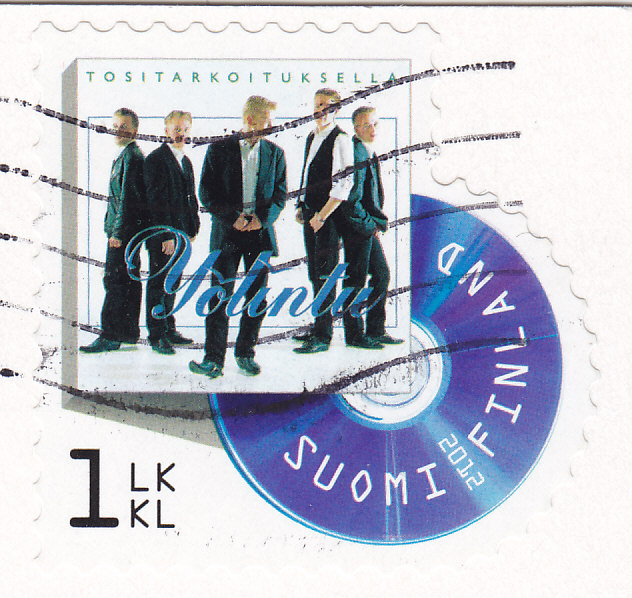I read the national epic of Finland Kalevala in my student years. I found it great! I like its archaic text with alliterations and parallelisms. Most beautiful verses are words of Joukahainen's mother when she hinders her son for killing Väinämöinen. It is difficult to translate it. I hope its wonderful message can be understand.
Anyja tiltja meglőnie, His Mother forbids her son to shoot him,
Legott tiltja, tántorítja: She try to keep back him:
„Vejnemöjnent meg ne lőjed, "Don't shoot Väinämöinen,
Kalevhonit el ne öljed, Don't kill the man from Kalevala,
Vejnemöjnent ha lelőnéd, If you shot Väinämöinen,
Kalevhonit ha elölnéd, If you killed the man from Kalevala,
Vége világunk örömének, The happiness of our world would come to end,
Kivesz földünkről az ének.” The song would die out in our land."
It is no wonder I like Kalevala illustration cards very much. Fortunately Postcrossing is in Finland very popular. Therefore I have received numerous Kalevala cards.
My first Kalevala illustration was painted by Akseli Gallen-Kallela (1865–1931). He is one of Finland’s most important artists. From the very beginning of his career he captivated the attention of the art world with his naturalistic, unromanticized renderings of ordinary people. Later, his great works on subjects from Finland’s national epic the Kalevala made him the supreme interpreter of Finnish character as expressed in myth and the leading exponent of nationalist feeling in painting.
Title of the picture is "Kullervo departs for the war" (1901). Kullervo, son of Kalervo with blue foot cloth is riding and sounding his horn.
 |
| FI-1321544 |
My second Akseli Gallen-Kallela illustration was "Vengeance of Joukahainen". Joukahainen challenged Väinämöinen to a singing contest which he lost. He attempted to gain his revenge on Väinämöinen by killing him with a crossbow. On this picture is the moment when his mother try to talk him out of his plan.
 |
| FI-1546082 and FI-1674031 |
My third Kalevala card is a modern drawing. The Postcard was published by Finish Red Cross. The sender, Marjatta has written there is Väinämöinen's self-built boat.
 |
| FI-1571475 |
I have the left and right panels of Aino-Triptych painted by Akseli Gallen-Kallela. In exchange for his life Joukahainen promised his young sister Aino to Väinämöinen. On the left-hand panel can bee seen "The first meeting of Aino and Väinämöinen". This card was send by Angeltie, a very nice Finish woman. After receiving of my postcard she send me 22 great cards. Among them were four Kalevala illustrations.
The right panel the triptych depicted the scene: Aino laments her woes and decides to end her life rather than marry an old man. This postcard was send by postcrosser Smabbe. The stamp is also great!
 |
| FI-1577286 |
The three other Akseli Gallen-Kallela postcards from Angeltie are also beautiful. "Lemminkäinen's mother" (1897) is a harrowing scene. Lemminkäinen was a handsome, arrogant and reckless man. He shares a very close relationship with his mother who revives him after he has been drowned in the river of Tuonela.
"The defense of the Sampo" (1896) depicts Väinämöinen, Ilmarinen and Lemminkäinen fighting against Louhi the Mistress of the North. The three heroes sailed to Pohjola to recover the Sampo. Louhi conjures a great army, turns herself into an eagle and fights for the Sampo. In the battle the Sampo is lost to the sea and destroyed.
"Fratricide" (1897) is an illustration for the Kanteletar a collection of Finnish folk poetry compiled by Elias Lönnrot. It is considered to be a sister collection to the Kalevala.
Miért véres éles kardod, Why is your sharp sword bloody,
kedves fiacskám? my sweet son?
Testvérbátyám meggyilkoltam, I have murdered my brother,
drága jó anyám. my dear mother.
Other painters like Riitta Nelimarkka (1948– ) are inspired by Kalevala. On this picture she represented also the plunder of the Sampo. I have received this card from a Finish lady Elina on 12 Apr, 2013.
 |
| FI-1726962 |
On 22 Nov, 2012 I received a big envelope from Finland. There was a beautiful folded card in the envelope. The sender Raisa-Hannele wrote: "This card called "Playing of Väinämöinen" has been waiting quite a while in my box of cards. I wanted to send it to someone that knows just something about Kalevala." I am happy to be this someone! One of the earliest artists to depict a scene from the Kalevala is Robert Wilhelm Ekman (1808–1873). He was a significant teacher and painter of the Finnish romantic portraits and early national romanticism. I don't speak finish but I think the picture is the illustration of these verses:
Vanha viisas Väinämöinen
otti kantelon käsille,
ilon itsensä lähemmä.
Jo kävi ilo ilolle,
riemu riemulle remahti,
tuntui soitto soitannolta!
Tikä ollut olentoa,
ku' ei tullut kuulemahan
tuota soittoa suloista,
kajahusta kanteloisen.
 |
| FI-1598063 |
I like the beautiful winter stamp on the envelope too.
The last postcard for today is a Marimekko card inspired also by Kalevala. The bird is Sotka the pochard, from whose egg the world came into being. I like this modern picture very much. It is an interesting stamp on this postcard.












No comments:
Post a Comment